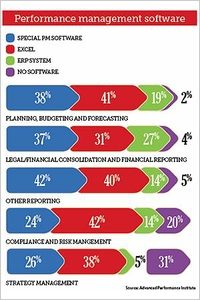Press Release: The following article written by Clive Keyte of Intrafocus appeared yesterday in the Sunday Telegraph
You’ve had your annual executive off-site meeting and spent a couple of days plastering the walls with flip-chart brainstorms and yellow stickies. The team building exercises in the bar were a great success. Finally, you have all agreed on the company vision and set out the strategy. The whole team is bought in and has made promises to deliver.
Yet after a month back in the office, the department is functioning as normal. Fire-fights are in full swing and you are wondering about how to get started on implementing the strategy. Three months pass and any initiatives that you started have begun to fizzle out and you realise the same thing happened last year. The day job has got in the way.
It is one thing to define a strategy; it is another to ensure a strategy is implemented. The leadership needs to spend time thinking about what they are measuring and monitoring and how this relates to business objectives and the company goals.
This process can be optimised by selecting the right software to record, manage and maintain the links between strategy, objectives, metrics and initiatives.
“Nowadays this is not optional,” says Clive Keyte, director at Intrafocus. “Using business scorecard software to efficiently manage these links can quickly tell us whether or not we are achieving our goals and ultimately our strategy.”
Previously, this activity was managed using spreadsheets and PowerPoint presentations. Anyone doing that in the current environment will find themselves listening to the voice inside their head saying: “Didn’t we do this last year? What’s changed? Has anything got better?”
The primary message contained in the article is clear: The use of software to manage strategy implementation is a not optional. If this is the case, why do so many companies still rely on spreadsheets and PowerPoint presentations to manage strategy, objectives, metrics and initiatives?
Over the past month we have been running a survey on Business Scorecard Usage. One of the questions asked is “What software do you use to manage your scorecard”. Surprisingly around 55% of the respondents say they use Spreadsheets and PowerPoint. Around 10% say that they use free form documents, so a staggering 65% of the respondents do not use any form of software to manage the way they collect data and report on progress! Granted these are early results but is not our expectation that these percentages will go down.
What does this mean in the context of implementing strategy successfully? We have long taken the view that strategy implementation requires a herculean effort in the initial definition of both meaningful objectives and measurable KPIs. Unless you can positively state what the outcome of strategy will be then you really do have to question whether or not the strategy is valid or achievable.
This being the case, the objectives and KPIs have to be monitored and managed with as much vigour throughout the strategic period as the effort to define them at the beginning of the exercise. This cannot be done effectively with spreadsheets and PowerPoint presentations. As much as we would like to believe we have control over these documents, the simple fact that they have been designed to be updated and distributed at will by individuals means all control has been lost. The only way to implement strategy successfully in today’s environment is to provide a single source of controlled information with update permissions given to the few who actually ‘own’ the areas of activity, objectives, KPIs and of course initiatives. This should be a software based system.


